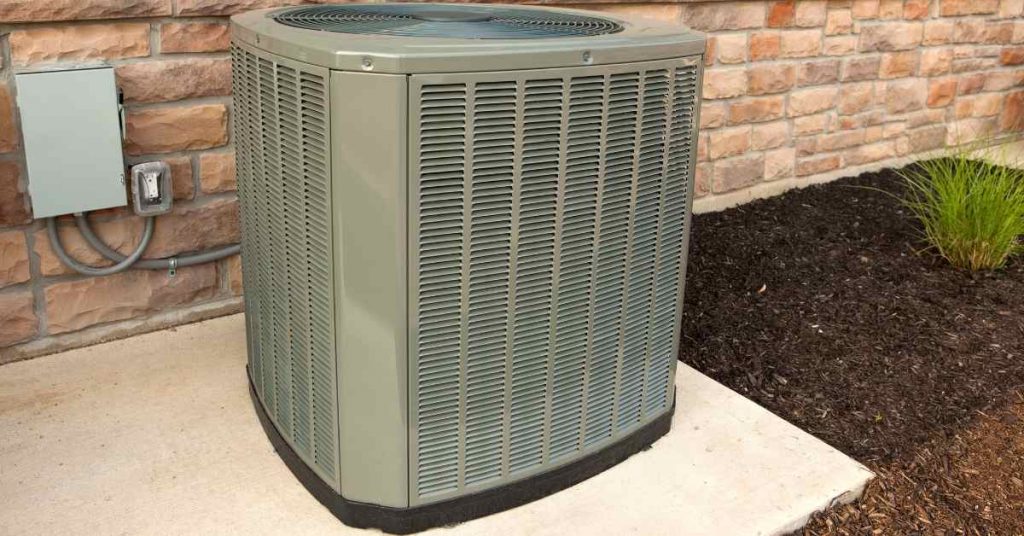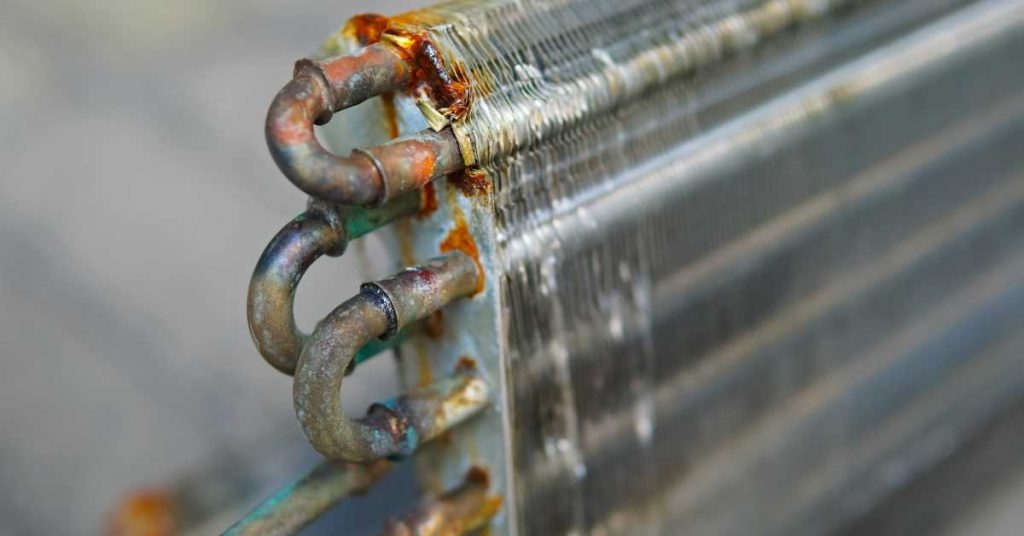
An AC (Air Conditioning) evaporator coil is a critical component of a central air conditioning system that plays a key role in the cooling process. Here’s a summary of what you need to know about AC evaporator coils:
- Function: The evaporator coil is located inside the indoor unit of your AC system. Its primary function is to absorb heat from the indoor air, cooling it in the process.
- Heat Exchange: The evaporator coil contains refrigerant, which evaporates as warm indoor air is blown over it by the system’s blower fan. This phase change from liquid to gas absorbs heat from the air.
- Cooling Process: As the refrigerant absorbs heat, it turns into a low-pressure gas. This cooled air is then circulated throughout your home, providing the desired cooling effect.
- Condenser Coil: After absorbing heat, the refrigerant travels to the outdoor unit and releases the absorbed heat in the condenser coil. This cycle of heat exchange allows the AC system to maintain a comfortable indoor temperature.
- Efficiency: A clean and well-maintained evaporator coil is essential for the AC system’s efficiency. Dust and debris can accumulate on the coil, reducing its ability to absorb heat effectively. Regular maintenance and cleaning can optimize performance.
- Common Issues: Evaporator coils can be prone to issues such as freezing due to restricted airflow, refrigerant leaks, or corrosion over time. These issues can lead to reduced cooling efficiency and the need for professional repairs.
- Sizing: Proper sizing of the evaporator coil is crucial for efficient cooling. It should match the capacity of the condenser unit to ensure balanced performance.
- Air Filter: Using a clean air filter is essential to prevent dust and debris from accumulating on the evaporator coil. A dirty filter can lead to reduced airflow and efficiency problems.
- Maintenance: Regular maintenance by a qualified HVAC technician, typically performed annually, can include cleaning the evaporator coil, checking for leaks, and ensuring proper refrigerant levels.
On average, an AC evaporator coil will last for 10 to 15 years. The coil can however last longer or shorter than that depending on quality and maintenance practices.
If your AC evaporator is about or more than 10 years old but faulty, it is not worth replacing just the coil. Replacing the entire AC system would be the best option. You can however replace just the evaporator coil if it is fairly new.
Replacing an AC coil will cost you between $800 and $2400 depending on size, location and brand among other factors. Out of that cost, 50-65% will be the labor charge. The actual part is not that expensive and will cost you between $300 and $1000.
The signs of a bad evaporator coil are warm air coming from the vents, banging or hissing noises from the system, AC not turning on, AC turning on and off frequently but not cooling properly, leaking refrigerant from near the indoor AC unit among others.
If you have a heat pump and not a conventional air conditioner, the role of your evaporator coil will be reversed during the cold months of winter when the heat pump is used to heat the house.
Instead of the refrigerant absorbing heat from the indoor air, it will supply the indoor air with heat extracted from outside. That is made possible by a reversing valve which reverses the direction of flow of the refrigerant.
How an AC Evaporator Coil Works

It is impossible to understand how an air conditioner evaporator coils works without also understanding how other parts work.
Let us therefore look at how the entire air conditioning system works but with more emphasis on the evaporator coil.
As I have mentioned, the air conditioning system has 3 main components. We can also add another component called expansion valve. It is a small but very important part in air conditioning.
The components are joined together using copper tubes, making it a closed loop system. A refrigerant is circulated through these components where it carries heat from one point to another.
In the process of heat exchange, the refrigerant changes from gas to liquid and back to gas again over and over again. As such, refrigerants needs to have a very low boiling point.
Freon (R-22) has been the refrigerant of choice for many years but being and CFC it has been phased out due to its effects on global warming. R-410A is now the refrigerant used in modern AC systems.
1. Compressor
The AC compressor is housed inside the condenser unit. It is the heart of the system. A compressor works like a pump to keep the refrigerant circulating throughout the system.
The refrigerant enters the compressor as a low-pressure gas. It is then compressed and its pressure increases drastically.
Note: The refrigerant entering the compressor carries heat from the evaporator coil inside the house.
The heat needs to be released to the surrounding air. The problem however is that the air outside is hot as well, since that would be during the hot months of summer.
For heat exchange to happen, there needs to be a temperature differential. In thermodynamics, heat is transferred from a point of high concentration to a point of low concentration.
And that is where the compressor comes in. You see, when you compress a gas, it is not its pressure only that increases. Its temperature increases as well.
As such, the refrigerant leaves the compressor and enters the condenser coil as a high-pressure superheated gas.
2. The Condenser Coil

Inside the condenser coil, the refrigerant can now lose the heat to the surrounding due to the temperature differential created by the compressor.
A fan at the top of the condenser unit accelerates this process. It blows air over the condenser coil which absorbs heat from the refrigerant thereby increasing the rate of the heat exchanger.
The condenser tubes are coiled back and forth to increase the surface area for maximum heat exchange.
By the time the refrigerant is exiting the condenser coil it will have changed to its liquid state, having lost most of the heat it had.
3. The Expansion Valve
The expansion valve is located in the indoor unit just before the evaporator coil. It is a small valve that creates a restriction for the refrigerant.
Think of the expansion valve like a spray bottle. After the fluid inside the bottle passes through the tiny opening, it expands.

So, what is the role of the expansion valve?
An expansion valve simply does the opposite of the compressor. You see, even though the refrigerant has lost most of its heat at the condenser coil, it is not as cold as it needs to be. And that is where the expansion valve comes it.
The expansion valve reduces the pressure of the refrigerant and its temperature falls dramatically as well. As such, the refrigerant enters the evaporator coil as a very cold liquid.
4. The AC Evaporator Coil

An AC evaporator coil looks like an A-frame. The design is to simply increase the number of coils and thereby increase the surface area for maximum heat exchange. Some coils however have other complex shapes.
Evaporator coils have an impeller fan (cylindrical in shape) that pulls warm air from the house and pushes it over the coil. It is also responsible for circulating the cooled air back to the house.
If you have a central air conditioner, the warm air from the house will first be passed through a filter to remove dirt, lint and other impurities. The warm and clean air is then sucked to the evaporator coil through the return air ducts.
As the air flows over the evaporator coil, the refrigerant absorbs its heat and in the process cools it. The cold air is then released to the entire house through supply air ducts.
After absorbing heat from the air, the refrigerant vaporizes and flows out of the evaporator coil to the compressor. As I had mentioned earlier, refrigerants have a very low boiling points.
The cycle goes on and on until the house is sufficiently cooled.
What happens inside the evaporator is very similar to what happens on our skin when we sweat. As sweat evaporates from our skin, it leaves behind a cooling sensation.
Heat Pump Evaporator Coil
When a heat pump is used to cool the house, it functions the exact same way as an air conditioner. The process is however a little different when the heat pump is used to heat the house.
A heat pump has a device known as a reversing valve. In the cold months of winter, instead of the refrigerant flowing from the compressor to the condenser and then to the evaporator coil, it is reversed and therefore flows from the compressor to the to the evaporator coil and then to the condenser coil.
High-pressure superheated refrigerant gas leaves the compressor and enters the evaporator coil. The cold air inside the house absorbs heat from the refrigerant which is then supplied to the house.
After losing most of its heat, the refrigerant turns into its liquid state and heads out to the condenser coil. Before that, the refrigerant passes through an expansion valve where its temperature is reduced even more than the outside temperature.
As such, the condenser coil will help the refrigerant extract heat from the outside air even when it is cold. Heat pumps will comfortably extract heat from the outside air as long as temperatures don’t dip below 35 degrees.
Conclusion
And basically that is how an air conditioner evaporator coil works. I hope that this post was helpful to you.






